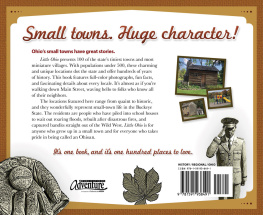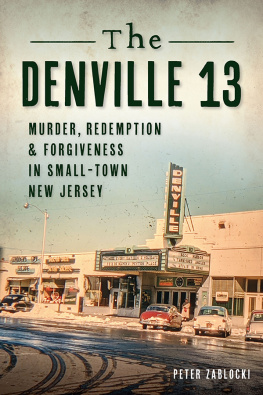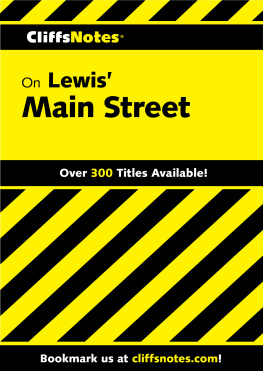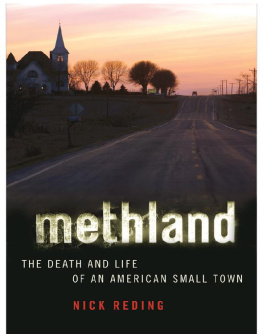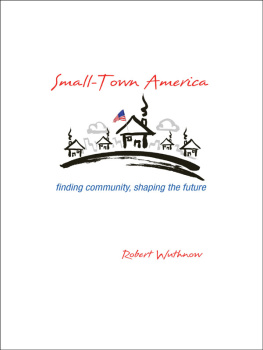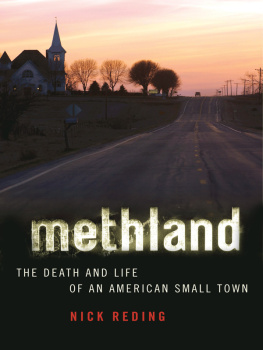Part I
CULTURES OF COMMUNITY
The first feature of Viroqua to make a deep impression on me was the larger-than-life fiberglass bull that stared sternly out over drivers on Highway 14 as they entered the town from the south. The bull advertised what was, at the time of my first visit in December 2000, a restaurant called Rickys. Passing the bull and heading into the downtown proper, I passed the VFW hall on the right, the Century 21 real estate office on the left and, shortly after that, the Latter-day Saints church, the optometry office, the Vernon County Historical Society Museum, and Vernon Memorial Hospital, before entering the designated historic section of the downtown. These two blocks of Main Street were lined with brick one- and two-story buildings that housed shops at the street level with apartments and offices above. The first block was home to Garys Rock Shop, Dairyland Printing, Clark/ Peterson Motors, Dahl Pharmacy, Buzzys Furniture and Buzzys Country across the street (specializing in country-style furnishings and decor), and a long, low building housing an IGA supermarket that later became a branch of the Western Wisconsin Technical College. At the end of this block, a traffic light stopped travelers at the intersection of Highway 14 and Jefferson Street. A right on Jefferson led to Viroquas post office and the MacIntosh Public Library.
Continuing north on Main Street, I passed Rockweiller Appliance, the Bramble Press bookstore, Bonnies Wedding Center, Art Vision, two banks (Citizens First Bank and the Bank of Virginia), and the Viking Inn restaurant. Across the street were the Temple Theatre, the Common Ground coffee shop, Box Office Video, Center Stage clothing, a second-hand shop called Second Time Around, Felixs clothing store, and Soda Jos diner. The marquee over the Temple Theatre heralded a film festival to raise money for the theaters $2 million renovation that was eventually completed in 2002. The citys second traffic light stopped me at the intersection with State Highways 56 and 82. Taking a right on Highway 82 leads the traveler to the parking lot of Nelsons Agri-Center and the American Legion hall and bar. Turning around and following Highway 56 in the other direction took me toward the courthouse and the public schools and into the residential neighborhood where I would eventually live.
The afternoon that I visited Viroqua for the first time, I ate lunch at Soda Jos diner, which then occupied the space that later housed Bella Luna, an Italian restaurant. The waitresses at Soda Jos wore saddle shoes, and they sometimes sang along with the oldies broadcast over the restaurants sound system. The walls were cluttered with 1950s and 1960s memorabilia, including 45 records and LP album jackets. A pair of penny loafers was affixed to the wall at the bottom of a pair of black pants and a white T-shirt that were stapled to the wall in a way that suggested a two-dimensional dancer frozen in mid Twist.
After finishing my slice of banana cream pie and paying the waitress at the diners vintage cash register, I stepped outside and spent a moment surveying Viroquas main street. I was struck, as I would be again and again, by the quintessential Midwest downtown aura of the shop fronts, the knots of laughing kids, and the patient dogs lounging in the backs of parked pickup trucks. The lunchtime crowd was slowly trickling out of the diner and out of the Viking Inn, diagonally across the street. A little girl struggled to pile into a minivan with her older siblings while remaining in command of a dripping ice cream cone. Down the street a Buick sedan pulled into the IGA parking lot (by the building that later became the Tech College). Its elderly driver alighted and made his way around the cars wide front end to open the passenger-side door for a woman I assumed to be his wife.
On the surface at least, Viroqua had the timeless character that many Americans associate with small towns. The pastiche of historic eras represented in the downtown by features like the reproduction 1930s lamps lining the street, the 1920s theater, and the 1950s diner did not give the sensation of stagnation in any particular era. Instead, it gave the impression of stepping out of time, and suggested that time was perhaps not the most important consideration there. Timelessness is an important feature of the way Americans think about small towns, especially those in the Midwest. The rest of the world may be cruising down the fast lane, but the small towns of the heartland never seem to be in any such hurry.
A visitor might be able to maintain this illusion of timelessness if he or she did not continue traveling north, past the downtown area, where there are familiar franchise restaurants and stores: Country Kitchen, Pizza Hut, McDonalds, Wal-Mart. There is also an entrance to the towns industrial park and to the large steel building housing a National Cash Register company factory that specialized in producing labels.
In this book I examine the variety of ways that the citizens of this quintessential yet unique small Midwestern town make community together. The first four chapters, which make up part 1, explore in depth the three principle orientations that Viroquans had to making community and how differences in the fundamental commitment to Viroqua itself and the sense that community is something to deliberately create led to important social distinctions. These differences also led to residents having different sets of practices as community members in an everyday sense. In chapter 1 I present an overview of the three different groups I encountered in Viroqua and the ways they celebrated a major cultural holiday. I begin looking at the groups in more detail in chapter 2 with a consideration of those I call the Alternatives, not because they are the most important residents, or even the largest group of residents, but because they were so visible as a group and their presence was somewhat surprising. In chapters 3 and 4 I analyze the cultures of community in the Main Street and Regular groups respectively.
In part 2 I examine the ways that residents different ideas about community manifest themselves in a number of aspects of commercial life. Viroquans ethics of agency and logics of commitment guided their actions when it came to mundane decisions about exchanging goods and services, and in these arenas we can see how the different models of making community played out in everyday life.
The books concluding chapter examines some of the opportunities and constraints each group faced in Viroqua. It extends the idea that community making anywhere might be fruitfully understood through cultural analysis of the logics of commitment and ethics of agency.
THREE HALLOWEENS, THREE VIROQUAS
By three-thirty in the afternoon, it was nearly impossible to walk down Main Street without being poked by a witchs broomstick or swatted with a fairys magic wand. Small Spider-Men darted among ghosts wearing plastic Scary Movie masks with flashing red lights. A giggling chain of Snow Whites and Cinderellas snaked out of Felixs clothing store holding hands and ran (as fast as possible considering the crowds) up the sidewalk to the next store on the block. The sidewalks were swarming with children of all ages, including some teenagers. It was a scene of unmitigated collective glee.
The kids did not seem to care (or even notice) that many other kids were dressed in Halloween costumes identical to their own. When two Incredible Hulks passed each other on the sidewalk, they did not even glance at each other. The vast majority of children were wearing store-bought costumes representing familiar commercial characters. The Snow Whites were obviously Snow Whites because their costumes evoked Disneys animated Snow White. Children did vary in the degree to which their parents had mandated concessions to the late-fall temperatures, so some of the Hulks muscles were clearly augmented by sweaters, while others remained lean. Costume originality, however, was not the point of the event. Candy was.
Next page


